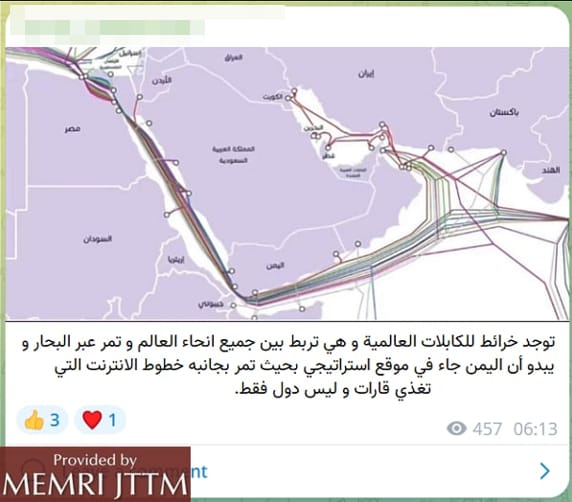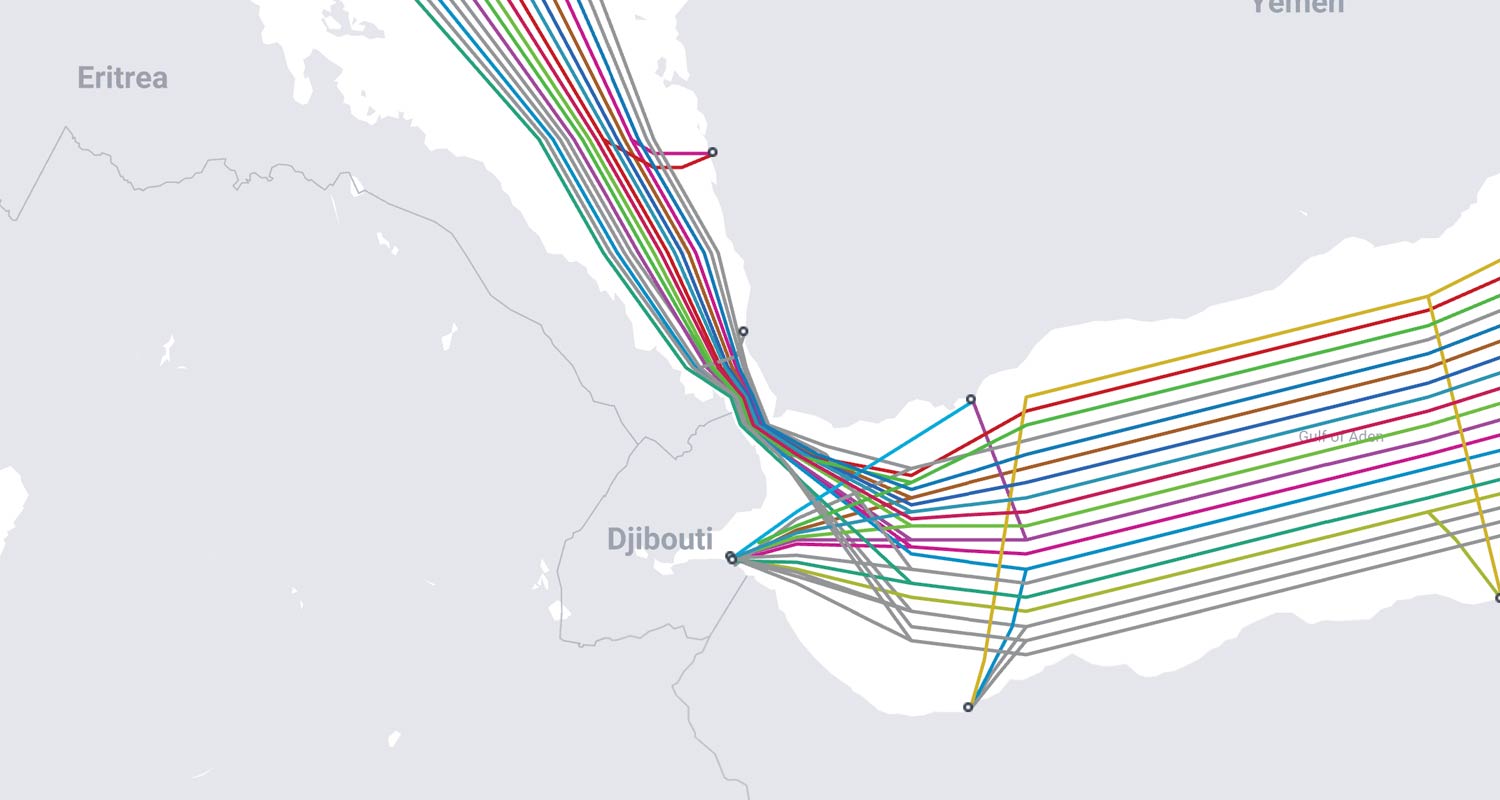
An
aerial view shows the Bab el-Mandeb Strait, a sea route connecting the
Indian Ocean and the Mediterranean Sea via the Suez Canal.
An aerial view shows the Bab el-Mandeb Strait, a sea route connecting the Indian Ocean and Mediterranean Sea via the Suez Canal, on Oct. 22, 2022.
An aerial view shows the Bab el-Mandeb Strait, a sea route connecting the Indian Ocean and Mediterranean Sea via the Suez Canal, on Oct. 22, 2022.
GALLO
IMAGES/ORBITAL HORIZON/COPERNICUS SENTINEL DATA 2021
From Foreign Policy by Keith Johnson
Cutting or damaging subsea cables could disrupt data and financial communications between Europe and Asia.
In the midst of the 12-week campaign by Iran-backed Houthi militants in Yemen to disrupt the critical shipping corridor of the Red Sea, a new worry is creeping in: that the Houthis may target the bevy of subsea cables that carry nearly all the data and financial communications between Europe and Asia.
So far, most of the concern about the Houthi campaign has understandably focused on its disruptive impact on commercial shipping and energy flows through the key chokepoint between the Suez Canal and the Indian Ocean.
But this new concern underscores the way in which subsea infrastructure—and its potential vulnerability—is becoming a critical feature in the global security seascape.
In late December, an account linked to Houthi militants posted on Telegram what appeared to be threats against the dozen-odd fiber-optic cables that squeeze through the Bab el-Mandeb Strait west of Yemen.
In late December, an account linked to Houthi militants posted on Telegram what appeared to be threats against the dozen-odd fiber-optic cables that squeeze through the Bab el-Mandeb Strait west of Yemen.
The nebulous threats were echoed and amplified by accounts linked to other Iran-backed militants, including Hezbollah, according to the Middle East Media Research Institute.
In recent years, key infrastructure on the seafloor has become part of the gray-zone battleground, with Russian “ghost ships” spooking neighbors in the Baltic and North seas.
In recent years, key infrastructure on the seafloor has become part of the gray-zone battleground, with Russian “ghost ships” spooking neighbors in the Baltic and North seas.
More than a year ago, the Nord Stream 1 gas pipeline between Russia and Germany was mysteriously blown up (while Nord Stream 2 was damaged), and last fall, energy and data links in the eastern Baltic were also mysteriously damaged.
Similar episodes have plagued data connections in the Mediterranean.
On December 24, 2023, a Telegram channel affiliated with Yemen's Iran-backed Ansar Allah Movement (the Houthis) shared a map of networks of submarine communications cables in the Mediterranean Sea, the Red Sea, the Arabian Sea, and the Persian Gulf.
The map was accompanied by an implied threat: "There are maps of international cables connecting all regions of the world through the sea. It seems that Yemen is in a strategic location, as internet lines that connect entire continents – not only countries – pass near it."
courtesy of MEMRI
Subsea cables are packed densely together at Bab al-Mandeb (the Gate of Tears) off the Yemeni coastline.
Image from TeleGeography’s Submarine Cable Map
While the vague threats to submarine cables in the Red Sea have not so far led to any incidents, the centrality of their target is clear—there are few other ways to move the massive amounts of data and money between Europe and Asia than by relying on a bundle of fiber-optic cables that snake through the very area where the Houthis are most active.
“Well over 99 percent of intercontinental communications go over subsea cables—that’s not just internet, that’s financial transactions, interbank transfers.
“Well over 99 percent of intercontinental communications go over subsea cables—that’s not just internet, that’s financial transactions, interbank transfers.
A lot of defense departments rely on cables as well,” said Timothy Stronge, vice president of research at TeleGeography, a telecoms market research company.
“Pretty much anything you can imagine for international communications touches undersea cables. In terms of the Red Sea, it’s pretty critical for connecting Europe to Asia.”
Threats aside, the first big question is whether the Houthis actually have the capability to damage the submarine cables, which are usually well embedded in the seafloor; most of the Houthi attacks so far have come from firing missiles and launching drones at commercial vessels (and U.S. and U.K. naval ships) in the area.
“I can’t see any part of the Houthi arsenal actually being dangerous for the subsea cables,” said Bruce Jones of the Brookings Institution, who has written extensively about the importance of submarine cables.
Threats aside, the first big question is whether the Houthis actually have the capability to damage the submarine cables, which are usually well embedded in the seafloor; most of the Houthi attacks so far have come from firing missiles and launching drones at commercial vessels (and U.S. and U.K. naval ships) in the area.
“I can’t see any part of the Houthi arsenal actually being dangerous for the subsea cables,” said Bruce Jones of the Brookings Institution, who has written extensively about the importance of submarine cables.
“If you actually want to damage these things, you’re going to have to get subsea.”
The Houthis, though, are backed and armed by Iran and used by Tehran as one of its regional proxies to attack Western and Gulf interests.
The Houthis, though, are backed and armed by Iran and used by Tehran as one of its regional proxies to attack Western and Gulf interests.
Even if the Houthis themselves may lack the capability, Jones said, Iran might be a different story, especially as tensions between the United States and Iran escalate.
“The question becomes, do the Iranians have the capability, and would the Iranians take that step? I think that is the thing to watch for—if this escalates farther and we really get into a U.S.-Iran slogging match … then you could question whether the Iranians have that capability,” he said.
That said, there are potentially low-tech ways to damage some undersea cables, especially in locations where they are laid in shallower waters.
“The question becomes, do the Iranians have the capability, and would the Iranians take that step? I think that is the thing to watch for—if this escalates farther and we really get into a U.S.-Iran slogging match … then you could question whether the Iranians have that capability,” he said.
That said, there are potentially low-tech ways to damage some undersea cables, especially in locations where they are laid in shallower waters.
About two-thirds of all incidents involving maritime cables involve human accident, Stronge said, usually from fishing trawlers or commercial vessels dragging their anchors on the seafloor.
Experts said such an approach could conceivably give the Houthis the ability to partially damage at least some of the submarine cables.
Normally, that wouldn’t be a huge problem: The United States and most other nations keep cable-repair ships on retainer to patch any disruptions to the vital undersea data links.
Normally, that wouldn’t be a huge problem: The United States and most other nations keep cable-repair ships on retainer to patch any disruptions to the vital undersea data links.
But due to the Houthis’ ongoing harassment campaign in the Red Sea itself, it simply wouldn’t be possible for repair ships to spend several days stationary trying to repair a damaged cable.
In that sense, the submarine threat could dovetail with the surface disruption they are already causing.
Still, though, the big difference between undersea energy infrastructure, like the Nord Stream pipelines or the Baltic connectors, and the data links is that there are a lot more alternatives for moving virtual traffic than oil or gas.
Still, though, the big difference between undersea energy infrastructure, like the Nord Stream pipelines or the Baltic connectors, and the data links is that there are a lot more alternatives for moving virtual traffic than oil or gas.
Key Shipping Chokepoints in the Red Sea Region

A map shows major chokepoints in trade routes in the Red Sea area.
The Suez Canal, Bab el-Mandeb Strait, and the Strait of Hormuz are labeled.
Yemen is shaded in darker color.
“Individually, a cable is extremely vulnerable, but collectively there’s a lot of resiliency built into the system,” Stronge said.
“It would be extremely difficult to completely disconnect a well-connected country. It would require a very sophisticated and coordinated attack to take them out all at the same time.”
The bigger issue is the growing realization among defense planners and security analysts of the importance and vulnerability of the huge subsea infrastructure system around the world.
The bigger issue is the growing realization among defense planners and security analysts of the importance and vulnerability of the huge subsea infrastructure system around the world.
Oil and gas pipelines have proliferated, and subsea data links have grown by leaps and bounds in recent years and are poised for even more spectacular growth this year and next to keep up with the exponential demand for digital transmission.
Weaponizing the seafloor is not entirely novel: The British cut German submarine telegraph cables at the very start of World War I to isolate Berlin from the world, and seabed sonar in the Greenland-Iceland-U.K. gap became a fixture in the Cold War.
Weaponizing the seafloor is not entirely novel: The British cut German submarine telegraph cables at the very start of World War I to isolate Berlin from the world, and seabed sonar in the Greenland-Iceland-U.K. gap became a fixture in the Cold War.
But the growing importance of subsea infrastructure to the global economy is forcing a rethink of the traditional naval mission of protecting sea lines of communication.
Links :
- Business Insider : Houthis could cut undersea global internet cables, minister warns
- CTech : Could the Houthis potentially disrupt global internet communications?
- The Guardian : Houthis may sabotage western internet cables in Red Sea, Yemen telecoms firms warn
- BBC : Could the Houthis sabotage undersea cables?
- DailyMail : How the Houthis could get revenge on the U.S. for airstrikes by cutting a FIFTH of the world's internet
- GeoGarage blog : Two maps show why shipping firms are suspending routes ...


Globes : Houthis hit submarine communications cables">Houthis hit submarine communications cables
ReplyDeleteMaritime Executive: Up to Four Subsea Cables Have Been Damaged Off Yemen
ReplyDeleteBlog Telegeography : What We Know (And Don't) About Multiple Cable Faults in the Red Sea
ReplyDelete